| |

 The
ride to Kumbo was one of the group's favorite. Could it be because it is
largely paved? Is it because we didn't carry any packs? Or, is because the
ride is very pretty and Kumbo was very interesting? Actually, the group
says it is the latter! The
ride to Kumbo was one of the group's favorite. Could it be because it is
largely paved? Is it because we didn't carry any packs? Or, is because the
ride is very pretty and Kumbo was very interesting? Actually, the group
says it is the latter!
  Most
of the route is paved, the noticeable exceptions being the section right out of
Jakiri and the section right before Kumbo. Which raises the question, why
doesn't the government pave the roads near towns where it would probably benefit
the Most
of the route is paved, the noticeable exceptions being the section right out of
Jakiri and the section right before Kumbo. Which raises the question, why
doesn't the government pave the roads near towns where it would probably benefit
the most people? most people?
 The is still a lot of tree cover around Kumbo and a number of rivers and streams
run through is so it has a very nice setting. The
built sections of town are distributed over a number of hills -- The is still a lot of tree cover around Kumbo and a number of rivers and streams
run through is so it has a very nice setting. The
built sections of town are distributed over a number of hills --
 probably seven
because that is the classic number of hills for a city. probably seven
because that is the classic number of hills for a city.
 The most prominent
building in town is the Catholic Cathedral. The most prominent
building in town is the Catholic Cathedral.
 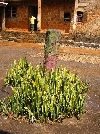 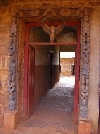 Our
first stop was the palace of the Fon of Nso'. He is the Fon of the Banso'
people (speakers of Lamnso'). The front of the palace has a large square to
handle large public gatherings. From this there is a hallway which leads
to the first Our
first stop was the palace of the Fon of Nso'. He is the Fon of the Banso'
people (speakers of Lamnso'). The front of the palace has a large square to
handle large public gatherings. From this there is a hallway which leads
to the first
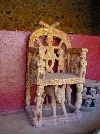 courtyard. The courtyard is used for events involving the Fon,
his senior advisors and a limited number of citizens. At
the head of the courtyard is a dais with a throne and other royal art. courtyard. The courtyard is used for events involving the Fon,
his senior advisors and a limited number of citizens. At
the head of the courtyard is a dais with a throne and other royal art.
 The
same throne has been here for at least twenty years. The throne is
supported by a leopard and people and while seated there the Fon could use a
lion as a foot rest, showing that he is above and more powerful than all of
these things. Advisors would sit to one side and the public on the other. The
same throne has been here for at least twenty years. The throne is
supported by a leopard and people and while seated there the Fon could use a
lion as a foot rest, showing that he is above and more powerful than all of
these things. Advisors would sit to one side and the public on the other.
 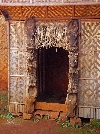 Another
hall way leads to a second, smaller courtyard, which has a throne and is used
for more private audiences with the Fon. At this throne the footrest is a
crocodile. Through a door out of this courtyard and a few twists and turns and
you get to the doorway to the Fon's private quarters (right). We weren't
invited in but the Fon came out to meet us (from a distance), asked us where we
were from and about our visit to Cameroon, and wished us well on our journey. Another
hall way leads to a second, smaller courtyard, which has a throne and is used
for more private audiences with the Fon. At this throne the footrest is a
crocodile. Through a door out of this courtyard and a few twists and turns and
you get to the doorway to the Fon's private quarters (right). We weren't
invited in but the Fon came out to meet us (from a distance), asked us where we
were from and about our visit to Cameroon, and wished us well on our journey.

  Outside
the palace there are a couple other points of interest connected with the elite
ranks of Banso' culture. Now a days these buildings
belong to men's societies that are involved with service projects and
preservation of the culture. Historically, these were secret societies of
hunters and warriors. Outside
the palace there are a couple other points of interest connected with the elite
ranks of Banso' culture. Now a days these buildings
belong to men's societies that are involved with service projects and
preservation of the culture. Historically, these were secret societies of
hunters and warriors.

 The large mosque next to the palace has an interesting story. The Muslim
population in Kumbo is rather small and the Fon, himself, is Catholic.
Historically, the mosque was at the top of the hill where the cathedral now
sits. The Fon offered the Muslim a site next to the palace for their
mosque if they would remove the other from the top of the hill. They
accepted the opportunity to be closer to the Fon. The cathedral was then
built at the top of the hill. It is not clear what the timing of all of
this was, who knew what when or where there are other back stories to the
transactions, but today the buildings are firmly established where they are. The large mosque next to the palace has an interesting story. The Muslim
population in Kumbo is rather small and the Fon, himself, is Catholic.
Historically, the mosque was at the top of the hill where the cathedral now
sits. The Fon offered the Muslim a site next to the palace for their
mosque if they would remove the other from the top of the hill. They
accepted the opportunity to be closer to the Fon. The cathedral was then
built at the top of the hill. It is not clear what the timing of all of
this was, who knew what when or where there are other back stories to the
transactions, but today the buildings are firmly established where they are.

 After
a hard morning of sightseeing it was time for another meal. On the left is
a sample of "water fufu" and on the right a plate of rice and okra, and rice and
what is locally called "huckleberry". The latter comes from a low growing
plant that has no resemblance to a North American huckleberry and has no berries
on it at this time of year. After
a hard morning of sightseeing it was time for another meal. On the left is
a sample of "water fufu" and on the right a plate of rice and okra, and rice and
what is locally called "huckleberry". The latter comes from a low growing
plant that has no resemblance to a North American huckleberry and has no berries
on it at this time of year.

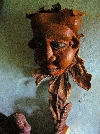 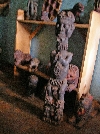 After
lunch we went to MusArts Gallery, a gallery/museum that was started by a
respected local
sculpture Daniel Musa and is now run by his son, Peter Musa. The gallery is located about three block behind the main Catholic
Cathedral. After
lunch we went to MusArts Gallery, a gallery/museum that was started by a
respected local
sculpture Daniel Musa and is now run by his son, Peter Musa. The gallery is located about three block behind the main Catholic
Cathedral.
 The
gallery has a collection of piece that the Musa'a have carved and collected.
Peter is happy to welcome travelers and guide them through the collection and
explain the purpose and symbolism of the items. The
gallery has a collection of piece that the Musa'a have carved and collected.
Peter is happy to welcome travelers and guide them through the collection and
explain the purpose and symbolism of the items.



 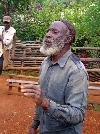 The
ride back to Jakiri will be remember for a particularly interesting exchange
that started as the purchase of a few banana. We came to learn that Yileh, the
banana seller is also a farmer with a variety of other crops, including coffee.
In additional to that he is a sculpture, so he brought out a sculpture.
When our group almost got into a bidding war over the sculpture he said he had
another almost like it. He went back for the second statue and brought a
couple of other piece. The other pieces weren't as interesting to the
group, but he sold both of the statues. When ask why he didn't have a sign
out announcing his artwork for sale he said then he would have to spend a lot
more time carving so he had and inventory and he would have to be there a lot
for the occasion that someone might stop to look at his wares. As it was,
what started as the sale of less than $1 of banana end with sale of a couple of
statues that equaled a good months pay for many Cameroonians. The
ride back to Jakiri will be remember for a particularly interesting exchange
that started as the purchase of a few banana. We came to learn that Yileh, the
banana seller is also a farmer with a variety of other crops, including coffee.
In additional to that he is a sculpture, so he brought out a sculpture.
When our group almost got into a bidding war over the sculpture he said he had
another almost like it. He went back for the second statue and brought a
couple of other piece. The other pieces weren't as interesting to the
group, but he sold both of the statues. When ask why he didn't have a sign
out announcing his artwork for sale he said then he would have to spend a lot
more time carving so he had and inventory and he would have to be there a lot
for the occasion that someone might stop to look at his wares. As it was,
what started as the sale of less than $1 of banana end with sale of a couple of
statues that equaled a good months pay for many Cameroonians.
Back in Jakiri for the night we surveyed the town for dinner. The choice
of restaurants seemed to be the one we had eaten at the night before and that
didn't overwhelm anyone in the group. That pretty much left the women
roasting fish and frying potatoes on the side of the road. The was one
stand just outside the hotel so we didn't have to go far, and we could get
drinks and use the tables and chairs from the bar connected to the hotel.
The women cooking the fish were very engaging and the food was excellent so we
had a great time eating "fish and chips".
 A
final note: Africans can be very resourceful and great problems solvers.
Generally it is difficult to attach a strong rear rack to a bicycle with a rear
suspension system. This image demonstrates that it can be done. A
final note: Africans can be very resourceful and great problems solvers.
Generally it is difficult to attach a strong rear rack to a bicycle with a rear
suspension system. This image demonstrates that it can be done.
|
Addendum:
Palace of the Fon of Nso, Kumbo


Here is one of the Fon's thrones, which he later
came and sat on.

In the event
that an audience with the Fon is granted, you are preceded by a
retainer. When coming into the presence of the Fon the proper etiquette is
to: clap your hands lightly to attract the Fon's attention and wait demurely
until it is granted. Commoners don't shake his hand. Don't sit unless he
invites them to and then don't cross their legs in front of him. When
addressing the Fon you avert your eyes, bow your head and cover your mouth
with a hand.
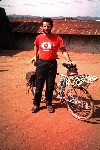
Perhaps it is not easy to see, but in the basket
on the back of the bicycle is a chicken. It was a gift from the Fon to
our group.
|



































